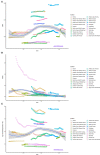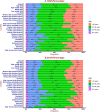Global, regional, and national burden of uterine fibroids in the last 30 years: Estimates from the 1990 to 2019 Global Burden of Disease Study
- PMID: 36419793
- PMCID: PMC9676237
- DOI: 10.3389/fmed.2022.1003605
Global, regional, and national burden of uterine fibroids in the last 30 years: Estimates from the 1990 to 2019 Global Burden of Disease Study
Abstract
Objective: To study specific information on trends in incidence, mortality, disability-adjusted life years (DALY) and the corresponding trends among five sociodemographic index regions, 21 regions, and 204 countries for decision-making, which would enable policymakers to distribute limited resources and devise policies more rationally.
Methods: Data on uterine fibroids (UNs) from 1990 to 2019, including incidence, mortality, and DALYs, were obtained from the 2019 Global Burden of Disease Study. An estimated annual percentage change (EAPC) was calculated to assess morbidity, mortality, and DALY trends.
Results: The incident cases of UFs increased from 5,769,658 (95%UI, 7,634,3995-4,274,824) incidences in 1990 to 9,643,336 (95%UI, 7,178,053-12,714,741) incidences in 2017, and the age-standardized incidence rate was steady at 225.67/100,000 persons (95%UI, 167.33-298.87) in 1990 to 241.18/100,000 persons (95%UI, 179,45-318.02) in 2019. The incidence ratio in the high sociodemographic index (SDI) region showed a unimodal distribution, with peaks in 2005. Between 2009 and 2017, the age-standardized death rate of UFs declined globally, especially in low-SDI and low-middle SDI regions. In contrast with 860,619 DALYs (95%UI, 473,067-1,505,289) in 1990, the number of DALYs was 1,378,497 (95%UI, 710,915-2,475,244) in 2019, which had increased significantly, whereas the age-standardized DALY rate decreased expressively with an EAPC of -1.93 (95%CI, from -2.16 to -1.71).
Conclusion: The global burden of UFs increased between 1990 and 2019, and the incidences and DALYs increased prominently worldwide, while the deaths from UFs had no evident growth. Lower SDI regions carried an incremental burden of UFs, while disease reduction was observed in higher SDI regions. It is high time we paid attention to the underprivileged regional quality of life and health protection.
Keywords: age-standardized rate; disability-adjusted life years; global burden of disease; socio-demographic index; uterine fibroids.
Copyright © 2022 Cheng, Li, Gong, Huang, Zhang and Yan.
Conflict of interest statement
The authors declare that the research was conducted in the absence of any commercial or financial relationships that could be construed as a potential conflict of interest.
Figures







Similar articles
-
Global epidemiological characteristics of uterine fibroids.Arch Med Sci. 2023 Oct 30;19(6):1802-1810. doi: 10.5114/aoms/171786. eCollection 2023. Arch Med Sci. 2023. PMID: 38058724 Free PMC article.
-
Trends and projections of inflammatory bowel disease at the global, regional and national levels, 1990-2050: a bayesian age-period-cohort modeling study.BMC Public Health. 2023 Dec 14;23(1):2507. doi: 10.1186/s12889-023-17431-8. BMC Public Health. 2023. PMID: 38097968 Free PMC article.
-
Global, Regional, and National Burden of Myocarditis From 1990 to 2017: A Systematic Analysis Based on the Global Burden of Disease Study 2017.Front Cardiovasc Med. 2021 Jul 2;8:692990. doi: 10.3389/fcvm.2021.692990. eCollection 2021. Front Cardiovasc Med. 2021. PMID: 34277742 Free PMC article.
-
Global, Regional, and National Burden of Ectopic Pregnancy: A 30-Year Observational Database Study.Int J Clin Pract. 2023 Dec 18;2023:3927337. doi: 10.1155/2023/3927337. eCollection 2023. Int J Clin Pract. 2023. PMID: 38146347 Free PMC article.
-
Global, regional, and national burdens of leukemia from 1990 to 2017: a systematic analysis of the global burden of disease 2017 study.Aging (Albany NY). 2021 Apr 4;13(7):10468-10489. doi: 10.18632/aging.202809. Epub 2021 Apr 4. Aging (Albany NY). 2021. PMID: 33820874 Free PMC article.
Cited by
-
Ureter adhesion to the fibroid.BMJ Case Rep. 2023 Nov 27;16(11):e257862. doi: 10.1136/bcr-2023-257862. BMJ Case Rep. 2023. PMID: 38011960 No abstract available.
-
The long-term trend of uterine fibroid burden in China from 1990 to 2019: A Joinpoint and Age-Period-Cohort study.Front Physiol. 2023 Jun 22;14:1197658. doi: 10.3389/fphys.2023.1197658. eCollection 2023. Front Physiol. 2023. PMID: 37427409 Free PMC article.
-
Population-based study of the reproductive risk factors for transvaginal ultrasound diagnosed uterine fibroids in Nigerian women.Sci Rep. 2023 Nov 2;13(1):18926. doi: 10.1038/s41598-023-44703-5. Sci Rep. 2023. PMID: 37919335 Free PMC article.
-
Epidemiological features of uterine fibroid-associated imaging changes in Chinese women of reproductive age: a retrospective study.BMJ Open. 2025 Jan 7;15(1):e085671. doi: 10.1136/bmjopen-2024-085671. BMJ Open. 2025. PMID: 39773792 Free PMC article.
-
The stem bark decoction of Myrianthus arboreus P. Beauv. (Cecropiaceae) shows anti-uterine leiomyoma effects in Wistar rat.Reprod Fertil. 2025 Jul 26;6(3):e250037. doi: 10.1530/RAF-25-0037. Print 2025 Jul 1. Reprod Fertil. 2025. PMID: 40626852 Free PMC article.
References
LinkOut - more resources
Full Text Sources

